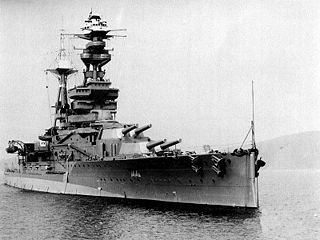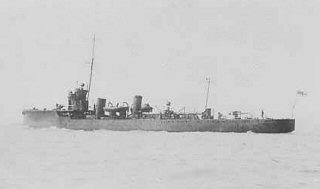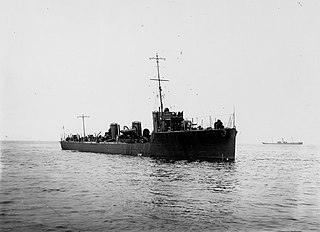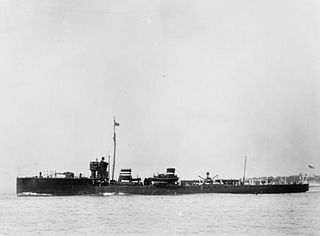
HMS Royal Oak was one of five Revenge-class battleships built for the Royal Navy during the First World War. Completed in 1916, the ship first saw combat at the Battle of Jutland as part of the Grand Fleet. In peacetime, she served in the Atlantic, Home and Mediterranean fleets, more than once coming under accidental attack. Royal Oak drew worldwide attention in 1928 when her senior officers were controversially court-martialled, an event that brought considerable embarrassment to what was then the world's largest navy. Attempts to modernise Royal Oak throughout her 25-year career could not fix her fundamental lack of speed and, by the start of the Second World War, she was no longer suitable for front-line duty.

HMS Iron Duke was a dreadnought battleship of the Royal Navy, the lead ship of her class, named in honour of Arthur Wellesley, 1st Duke of Wellington. She was built by Portsmouth Dockyard, and her keel laid in January 1912. Launched ten months later, she was commissioned into the Home Fleet in March 1914 as the fleet flagship. She was armed with a main battery of ten 13.5-inch (343 mm) guns and was capable of a top speed of 21.25 knots.

HMS King George V was the lead ship of her class of four dreadnought battleships built for the Royal Navy in the early 1910s. She spent the bulk of her career assigned to the Home and Grand Fleets, often serving as a flagship. Aside from participating in the failed attempt to intercept the German ships that had bombarded Scarborough, Hartlepool and Whitby in late 1914, the Battle of Jutland in May 1916 and the inconclusive action of 19 August, her service during the First World War generally consisted of routine patrols and training in the North Sea.

HMS Conqueror was the third of four Orion-class dreadnought battleships built for the Royal Navy in the early 1910s. She spent the bulk of her career assigned to the Home and Grand Fleets. Aside from participating in the failed attempt to intercept the German ships that had bombarded Scarborough, Hartlepool and Whitby in late 1914, the Battle of Jutland in May 1916 and the inconclusive action of 19 August, her service during World War I generally consisted of routine patrols and training in the North Sea.

The Acheron class was a class of twenty-three destroyers of the British Royal Navy, all built under the 1910–11 Programme and completed between 1911 and 1912, which served during World War I. A further six ships were built to the same design for the Royal Australian Navy as River-class destroyers. There was considerable variation between the design and construction of ships within this class, which should be considered as more of a post-build grouping than a homogeneous class.

HMS Shark, was an Acasta-class destroyer built in 1912 for the Royal Navy. Shark was sunk during the Battle of Jutland on the evening of 31 May 1916.

HMS Ardent was one of 20 Acasta-class destroyers built for the Royal Navy in the 1910s. Completed in 1914 she saw active service in the First World War, and was sunk at the Battle of Jutland in 1916.

HMS Hydra was one of 20 Acheron-class destroyers built for the Royal Navy in the 1910s. Completed in 1912, the ship participated in World War I and was sold for scrap in 1921.

HMS Blanche was the second of two Blonde-class scout cruisers built for the Royal Navy in the first decade of the 20th century. She led the 1st Destroyer Flotilla from completion until 1912 and was then briefly transferred to the 4th Destroyer Flotilla before the ship was assigned to the 3rd Battle Squadron in 1913. During World War I, Blanche was assigned to several different battleship squadrons of the Grand Fleet. She was present at, but did not fight in, the Battle of Jutland in mid-1916. The ship was converted into a minelayer in early 1917 and made 16 sorties to lay mines during the war. Blanche was paid off in 1919 and sold for scrap in 1921.

HMS Blonde was the lead ship of her class of scout cruisers built for the Royal Navy in the first decade of the 20th century. She led the 7th Destroyer Flotilla in the Mediterranean Fleet from completion until 1912. The ship was temporarily assigned to the 1st Destroyer Flotilla before she joined the 4th Battle Squadron in 1913. During the First World War, Blonde was assigned to various battleship squadrons of the Grand Fleet. The ship was converted into a minelayer in 1917, but never actually laid any mines. She was reduced to reserve in 1919 and sold for scrap in 1920.

HMS Boadicea was the lead ship of her class of scout cruisers built for the Royal Navy in the first decade of the 20th century. She led the 1st Destroyer Flotilla from completion until the ship was transferred to the 3rd Destroyer Flotilla in mid-1912. A year later Boadicea was reassigned to the 2nd Battle Squadron and she spent the bulk of World War I with that squadron. The ship was present at, but did not fight in, the Battle of Jutland in mid-1916. Boadicea was converted into a minelayer at the end of 1917 and made three sorties to lay her mines before the end of the war. She was placed in reserve after the war and taken out of service in 1920. The ship was used for harbour service at Dartmouth until she was sold for scrap in 1926.

HMS Acheron was the name ship of the Acheron-class destroyer of the British Royal Navy. She is named after the River Acheron, believed in Greek Mythology to be a branch of the River Styx. She was the fifth ship of the Royal Navy to bear the name.

HMS Lurcher was a modified Acheron-class destroyer, named after the lurcher-type dog, and the fifth ship of the Royal Navy to bear the name; when new she was the fastest ship in the Royal Navy.

HMS Firedrake was a modified Acheron-class destroyer, named after the firedrake of Teutonic mythology, and the sixth ship of the Royal Navy to bear the name.
HMS Owl was an Acasta-class destroyer of the Royal Navy, launched in 1913. The destroyer was part of the Grand Fleet during the First World War and took part in the Battle of Jutland. Owl survived the war and was sold for scrap in 1921.

HMS Forester was an Acheron-class destroyer of the Royal Navy that served during World War I and was sold for breaking in 1921. She was the ninth Royal Navy ship to be named after the traditional craft of forester.

HMS Lapwing was an Acheron-class destroyer of the Royal Navy that served during World War I and was sold for breaking in 1921. She was the seventh Royal Navy ship to be named after Vanellus vanellus, the northern lapwing.

HMS Sandfly was an Acheron-class destroyer of the Royal Navy that served during World War I and was sold for breaking in 1921. She was the seventh Royal Navy ship to be named after the small biting fly of the same name.
HMS Christopher was an Acasta-class destroyer of the British Royal Navy. She was built by Hawthorn Leslie in 1911–1912. She served throughout the First World War, forming part of the Grand Fleet until 1916 and taking part in the Battle of Jutland. Later in the war she served in the English Channel to protect merchant shipping against attacks by German U-boats. Christopher was sold for scrap in May 1921.

















